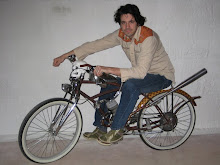




The inside of the rim has been fared smooth with an 80 grit sanding ball in preparation for the first layer of Carbon. Just before I laminate in the Carbon fiber I take my thickness gauge and measure the rim's thickness to see if there are any anomalies. This helps me determine how thick the carbon fiber actually is after its laid down. When I do my final shaping I then know exactly how much wood I have to play with and I eliminate the chances of blindly going along and risking sanding through the wood and exposing the carbon fiber.
The neck block is fashioned out in 1" thick pieces of quarter sawn Basswood. Each piece is scribed into the neck area separately and then they are glued together as one - in this case 5 pieces were used to create a nice spread out neck block. By increasing the mass in this area of the guitar it will give me the surface area needed for a stable joint and it also tapers beautifully back into the sides. The neck block will be laminated with Carbon Fiber across the grain to assure maximum strength and stability. My neck blocks are carved and in this case I went with an Art Deco inspired winged shaped. By adding more curves to the neck block I increase the effect of the strength of the Carbon Fiber. A curved wall is stronger than one that is not.
The neck pieces have been cut out. It will be my standard nine lamination design - 5 of wood and four of Carbon Fiber. The middle piece is blond flame maple and it has been tapered to match the neck shape. The rate of taper matches the neck thickness taper and the same taper will be reflected in the peghead. These little area of detail are what separate guitars from one another - attention to detail and a well thought out aesthetic are just as paramount as the function. Form and function should always be seamlessly fused.
The top wood for this axe will be carved from a beautiful piece of Ancient Kauri wood from New Zealand. The wood was found by Kiwi farmers while they were plowing their fields. They unearthed these massive trees from an ancient bog where oxygen did not exist. They had the trees carbon dated at 50, 000 years old! They were naturally knocked down in the last ice age and the wood predates the Wholly Mammoth by 10, 000 years - lots of mojo in this stuff! The wood is figured and they refer to the figure as whitebait. The story is that when the trees were underwater these little schools of fish would be constantly swimming overhead and interrupting the sunlight which in turn created the phenomenon in the wood. This is the same legend like story of bearclaw spruce - that the figure in the wood was created by a bear clawing at the tree. I love wood.














